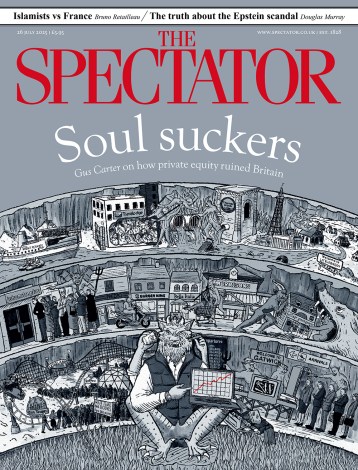It’s been 80 years since CS Lewis’ remarkably prescient, That Hideous Strength, was published. The final book in a sci-fi trilogy, the novel recounts the battle for the soul of humanity in the heart of England. Even in 1945, George Orwell saw that: ‘Plenty of people in our age do entertain the monstrous dreams of power that Mr Lewis attributes to his characters [the NICE scientists], and we are within sight of the time when such dreams will be realisable.’ Little did he realise how soon his fears would play out.
Little did Lewis realise how soon his fears set out in That Hideous Strength would play out
That Hideous Strength focuses around the National Institute of Coordinated Experiments (NICE), which aims to bring Britain under the rule of Science, beginning the process of transforming the human race into an inorganic species governed by a single, immortal leader.
‘The human race is to become all Technocracy,’ NICE high-up Professor Augustus Frost explains to recruit Mark Studdock. The plans include the sterilisation and selective breeding of the population, with indoctrination achieved through biochemical conditioning and the ‘direct manipulation of the brain’. Ultimately, organic life is to be abolished: the new humans will be formed of chemicals and live on a ‘clean’ planet divested of vegetation. Crucially, without sex, man ‘will finally become governable’.
Eighty years on, the story reads like a fictional exploration of transhumanism and current technologies, from chips in the brain to global digital systems for identification and travel. A mysterious figure – part Arthurian, part Christ-like – leads the fight for an alternative future rooted in spiritual enlightenment and a wholesome kind of Englishness. Like The Chronicles of Narnia, That Hideous Strength is a classic tale of Good vs Evil but, as its subtitle A Modern Fairy-Tale for Grown-Ups suggests, it’s also a sober exploration of the direction ‘scientific progress’ is taking us.
NICE leaders choose Edgestow as the place to begin the takeover, where the ‘progressive element’ of the nearby university makes for easy pickings. The fellows nod through the sale of some college land while the faculty serves as a ‘recruiting office’ for the institute.
Their prize recruit is Mark, a ‘sociologist who can write’, to produce newspaper articles to persuade the British public that change is necessary. ‘It’s the educated reader who CAN be gulled,’ explains Lord Feverstone, a figure working with both government and NICE. ‘When did you meet a workman who believes the papers? He takes it for granted that they’re all propaganda and skips the leading articles…But the educated public, the people who read the high-brow weeklies, don’t need reconditioning. They’re all right already. They’ll believe anything.’
Deception will only be needed in the early stages: ‘Once the thing gets going we shan’t have to bother about the great heart of the British public’. And sure enough, NICE’s private police force are soon terrorising the people of Edgestow.
The signs the takeover is well underway have a curiously contemporary ring. Edgestow is home to a new population of imported workmen, prices have risen and the hotels have somehow passed into hands of NICE. A dense fog blankets the heart of England. Riots are engineered to get the powers justified by a state of emergency. The propaganda aimed at the working man is successful: in the pubs the locals blame the Welsh and Irish for the state of things.
Lured into NICE by the prospect of higher salary and status, corrupted by the need to please and belong, it takes the befuddled Mark a long time to understand what he’s dealing with. Just as he finally realises his life is in danger, it emerges that NICE’s aspirations are global. There is no point in attempting to flee to America, as the ‘claws’ of the institute are ’embedded in every country’.
By this point, some readers will be nodding in wonderment at how Lewis, writing during the Second World War, could have foreseen our present situation with such accuracy. Others will see familiar plot elements as stemming from dystopian fiction’s classic device of warning by way of exaggeration. Either way, the heart of the novel concerns choice. In the spiritual war playing out, a side must be taken and the last battle fought. There is no way to avoid confronting the ‘hideous strength’.
In this, the final book of the trilogy, it is ordinary English people who must make that choice. In the second, entitled Perelandra, Ransom, a venturesome Cambridge don who has travelled to Venus, is confronted with Unman, a kind of automated psychopath. Ransom attempts some typically English tactics: first talking his enemy, then ignoring him and finally running away. When Unman reappears, Ransom realises the only resolution is to kill him. But as a creature of dark, transhumanist forces, Unman cannot be destroyed by ordinary means. Ransom has to dig deep and it takes two goes, the first requiring physical courage and the second the psychological ability to face and overcome inner fears.
On earth, the encounter with the hideous strengthpresents just two paths: follow the transhumanists or join The Resistance. Mark’s wife Jane takes the latter path only after much hesitation and resisting the messages of her clairvoyant dreams. Lewis presents his heroine as a stereotypical woman of her times: hankering after independence while constrained by the conventional values of her society. Two moments of truth push Jane to join the community of the good based at a nearby manor house: her direct experience of evil when she is captured and tortured by NICE and her subsequent meeting with the community Director – a ‘bright solar blend of king and lover and magician’ – when she finds her world ‘unmade’.
Mark’s moral journey is messier and more human. Even when confronted with the truth about NICE and offered sanctuary with The Resistance, he still can’t quite make the right decision. Lewis captures the moral confusion of a weak character perfectly: ‘he wanted to be perfectly safe and yet also very nonchalant and daring’ while his mind was ‘one fluid confusion of wounded vanity and jostling fears and shames’.
All the while, Lewis studs the novel with details that convey the everyday quality of life on earth and the potential for goodness even in in times of evil. The horror of what is happening in Edgestow is counter-balanced with elements of English cosiness – just as in the depths of the Narnian winter, you can still have a good tea with Mr and Mrs Beaver.
I won’t ruin things with a spoiler – better to read the entire trilogy yourself. The reception of the book in 1945 may have been mixed, but this belated reviewer finds it brilliantly illuminating. That Hideous Strength has come into its time.







Comments